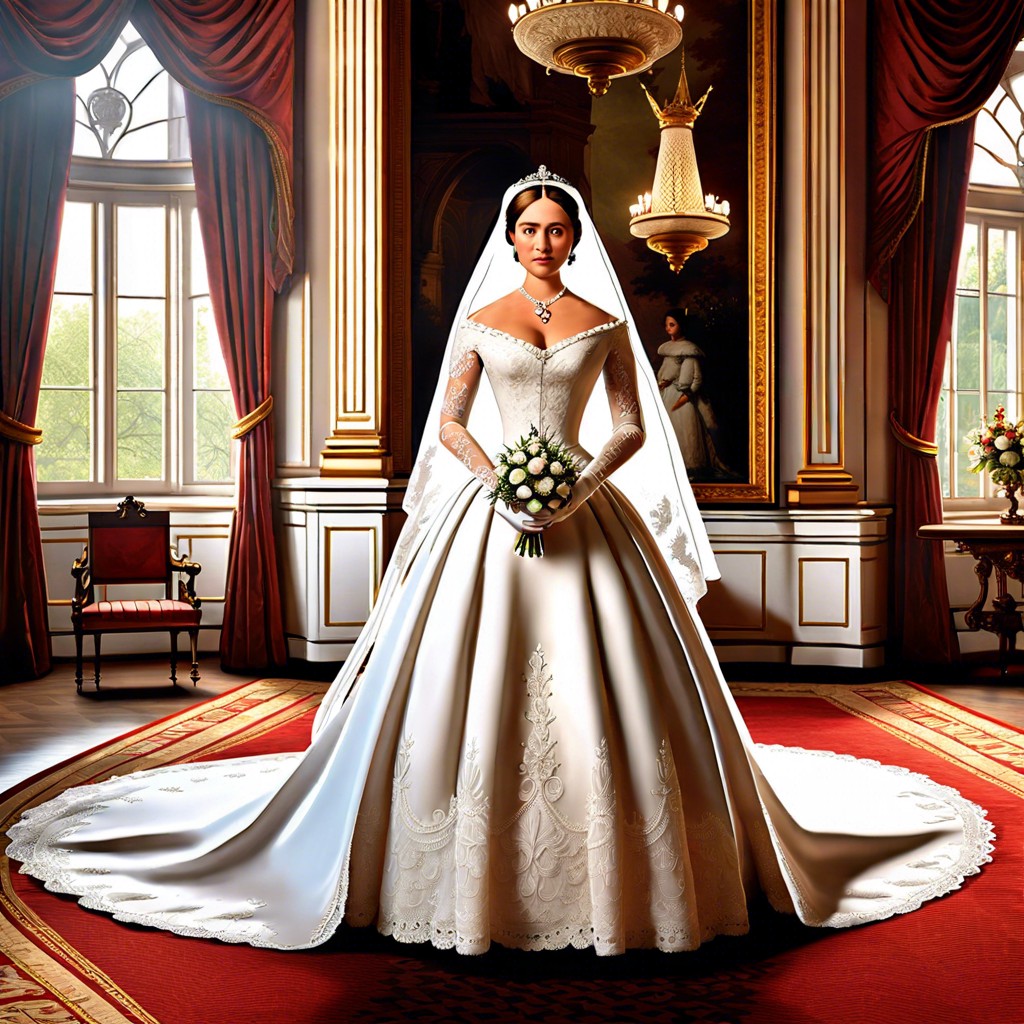Learn about the tradition of white wedding dresses and why this color became the symbol of bridal fashion.
Key takeaways:
- Queen Victoria popularized white wedding dresses in 1840.
- White symbolizes purity, innocence, and new beginnings.
- White has cultural and religious significance in many traditions.
- Different colors convey different meanings in wedding dresses.
- Modern couples add personal style and meaning to their wedding attire.
Queen Victoria’s Influence

Tying the knot hasn’t always been synonymous with a white gown. That trend was set in motion by none other than Queen Victoria when she married Prince Albert in 1840. Her choice to forgo the traditional royal silver gown for a white lace number was a fashion-forward move that caught everyone’s attention. It was a bold statement, as white was considered more of a color for ladies-in-waiting rather than queens. But hey, if it’s good enough for a queen, it’s good enough for the rest of us, right?
Before this royal trendsetter, brides simply wore their best dress, regardless of its color. Yet, post-Victoria, her sartorial pick became the gold standard for weddings. In essence, you could say she was the original bridal influencer. White dresses after her I do’s became all the rage, as women aimed to mimic her regal style. It seems that’s one royal wave that has yet to break!
Symbolism of Purity and Innocence
Diving right in—the traditional choice of a white gown often symbolizes a blank slate, echoing the start of a fresh chapter. Historically, brides selected white to represent purity, virginity, and a commitment to move forward in unity untouched by past relationships. This notion, while old-fashioned for some, remains a treasured sentiment that continues to charm many down the aisle.
It’s not all about the color itself, but what it conveys. The shade is linked to new beginnings and the unwritten future, inviting guests to witness a love story that’s as spotless and hopeful as the dress itself.
Even today, when a bride dons white, it’s viewed as a nod to tradition, honoring the union’s sanctity. Whether one subscribes to these meanings or not, there’s an undeniable romance in maintaining this connection with the past as couples step into marriage.
Cultural and Religious Significance
The pristine hue of a wedding dress has deep roots in various cultures and faiths. For many, the color white symbolizes a new beginning, representing the bridal transition from one chapter of life to another. In several Eastern traditions, white is associated with rituals and reverence, often reserved for sacred ceremonies and rites of passage.
In Christianity, white is frequently connected to purity and virtue, attributes historically ascribed to the bride on her wedding day. This significance is mirrored in the weddings of other religious contexts too, where the dress color acts as a visual metaphor for the spiritual purity of the occasion.
Adopting white can also reflect a honoring of ancestors and heritage, especially within cultures that view marriage as a significant milestone ordained by tradition. For some, wearing white is an expression of respect for these customs, becoming part of a familial and communal continuum.
While the symbolism can greatly vary across the globe, the choice of a white dress often embraces the profound gravity and joy of matrimonial celebrations, linking countless individuals across time and tradition with a simple yet powerful color choice.
Wedding Dress Color Meanings
Colors can whisper sweet nothings about a couple’s heritage or simply reflect their fashion-forward tastes. Take the color blue, often synonymous with loyalty and stability; it’s the “something blue” a bride might tuck away as a token of fidelity.
Venture east and red dresses take center stage, embroidered with luck and prosperity for a life shared. Meanwhile, blush gowns? They’re the soft-spoken romantics of the color wheel, offering a blush of tradition with a twist of modern charm.
Gold gowns gleam with opulence and grandeur, while bold brides may don black to parade an air of sophisticated elegance or individuality.
Each hue carries a secret melody of meanings, letting couples compose a symphony of sentiment that resonates on their special day.
Modern Interpretations
Breaking from tradition, couples today often infuse their weddings with personal style and meaning. Some brides choose shades like blush, gold, or even black to stand out and express their individuality. These bold choices can also reflect a couple’s story or complement the wedding’s theme and aesthetics.
Others might incorporate white in smaller elements, like accessories or detailing, blending modernity with tradition. Comfort and functionality have also swept into bridal fashion, with an emphasis on dresses that allow for movement and enjoyment throughout the celebratory affair.
Additionally, sustainability has become a key factor, with brides opting for eco-friendly fabrics or second-hand gowns as a nod to environmental consciousness.
Each color, fabric, and cut reflects the bride’s ethos and the spirit of the contemporary wedding—a canvas for the couple’s shared vision, breaking new ground for future traditions.



